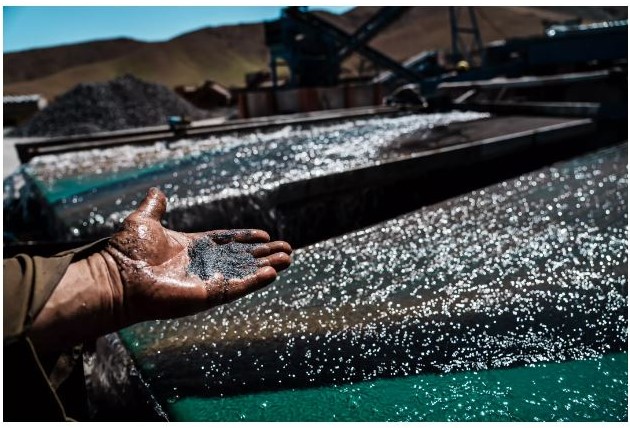CHROMITE
Composition of Logar Chromite Ore
Most chromite exported from Afghanistan is handpicked on site. Based on 18 such samples collected from sites in Logar and elsewhere in the Kabul Block, analyses were performed by AGS staff supervised by GTZ using
a Niton portable-XRF analyzer and gave a median content of 35.56% Cr (equivalent to 52% Cr2O3) and a Cr/Fe ratio
4). The statistical distribution
is lognormal and slightly lower than Volin reserve estimate given above, but higher than the median grade of 44% Cr2O3 for minor podiform deposits.
Chromite is an oxide mineral that an iron chromium oxide with formula: FeCr2O4. It is belonging to the spinel group. Chromite is the most important ore of chromium. Crystals are uncommon, but when found they are octahedral. Chromite is usually massive or in the form of lenses and tabular bodies, or it may be disseminated as granules. It is sometimes found as a crystalline inclusion in diamond. Chromite is dark brown to black in color and can contain some magnesium and aluminum. Chromite is most commonly found as an accessory mineral in iron- and magnesium-rich igneous rocks or concentrated in sediments derived from them. It occurs as layers in a few igneous rocks that are especially rich in iron and magnesium. Almost pure chromite is found in similar layers in sedimentary rocks. The layers are preserved when the sedimentary rocks metamorphose to form serpentinite. Referred to as chromitites, these rocks are the most important ores of chromium. The weathering of chromite ore bodies can also lead to its concentration in placer deposits.
Name: For its CHROMium content.
Association: Olivine, enstatite, plagioclase, serpentine, magnetite, ilmenite, pyrrhotite, pentlandite, ulvospinel.
Polymorphism & Series: Forms series with magnesiochromite and hercynite.
Chromite Composition: FeCr20 4. FeO = 32.0 per cent, Cr20 3 = 68.0 per cent. The iron may be replaced by magnesium, and the chromium by aluminum and ferric iron.
Diagnostic Features: The submetallic luster usually distinguishes chromite, but the green borax bead is diagnostic
Mineral Group: Spinel group.
Crystallography: Isometric; hexoctahedral. Habit octahedral. Crystals small and rare. Commonly massive, granular to compact.
Environment: In metamorphic Serpentine deposits, and also in ultrabasic igneous rocks, and in placer deposits. May also occur in meteorites.
Chemical Properties
| Chemical Classification | Oxide minerals, Spinel group |
| Formula | (Fe, Mg)Cr2O4 |
| Common Impurities | Mg,Mn,Zn,Al,Ti |
Chromite Physical Properties
| Crystal habit | Octahedral rare; massive to granular |
| Color | Black to brownish black; brown to brownish black on thin edges in transmitted light |
| Streak | Brown |
| Luster | Resinous, Greasy, Metallic, Sub-Metallic, Dull |
| Cleavage | None Observed |
| Diaphaneity | Translucent, Opaque |
| Mohs Hardness | 5,5 |
| Crystal System | Isometric |
| Tenacity | Brittle |
| Density | 4.5 – 4.8 g/cm3 (Measured) 5.12 g/cm3 (Calculated) |
| Fracture | Irregular/Uneven, Hackly, Sub-Conchoidal |
| Parting | Parting may develop along {111} |
| Other characteristics | Weakly magnetic |
Chromite Optical Properties
| Type | Isotropic |
| Color / Pleochroism | Non-pleochroic |
| RI values: | n = 2.08 – 2.16 |
| Twinning | On {111} |
| Birefringence | 0.0 |
| Relief | Very High |
Occurrence of Chromite
A cumulus mineral in ultramafic portions of layered mafic igneous rocks; an accessory mineral in alpine-type peridotites; also detrital. Common in all meteorites, except carbonaceous chondrites, and in lunar mare basalts.
Chromite is a common constituent of peridotite rocks and the serpentines derived from them. One of the first minerals to separate from a cooling magma; large chromite ore deposits are thought to have been derived by such magmatic differentiation.
Chromite Uses Area
The only ore of chromium. Chromium is used with various other metals to give hardness to steel, also as a plating material because of its non-corrosive nature. Chromite bricks are used to a considerable extent as linings for metallurgical furnaces, because of their neutral and refractory character. The bricks are usually made of crude chromite and coal tar but sometimes of chromite with kaolin, bauxite, or other materials. Chromium is a constituent of certain green, yellow, orange, and red pigments and of similarly colored dyes.







